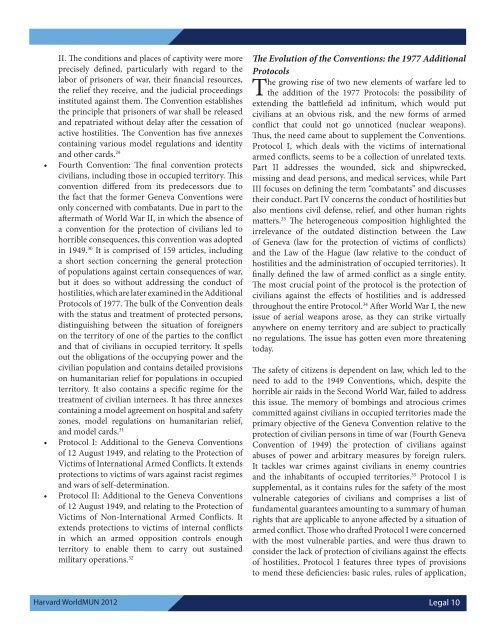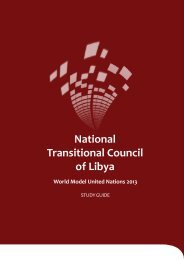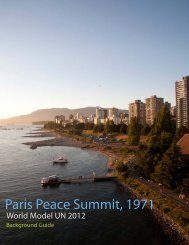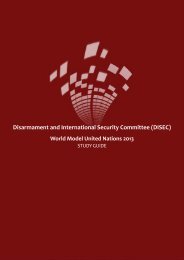Legal Committee - World Model United Nations
Legal Committee - World Model United Nations
Legal Committee - World Model United Nations
Create successful ePaper yourself
Turn your PDF publications into a flip-book with our unique Google optimized e-Paper software.
II. The conditions and places of captivity were more<br />
precisely defined, particularly with regard to the<br />
labor of prisoners of war, their financial resources,<br />
the relief they receive, and the judicial proceedings<br />
instituted against them. The Convention establishes<br />
the principle that prisoners of war shall be released<br />
and repatriated without delay after the cessation of<br />
active hostilities. The Convention has five annexes<br />
containing various model regulations and identity<br />
and other cards. 29<br />
• Fourth Convention: The final convention protects<br />
civilians, including those in occupied territory. This<br />
convention differed from its predecessors due to<br />
the fact that the former Geneva Conventions were<br />
only concerned with combatants. Due in part to the<br />
aftermath of <strong>World</strong> War II, in which the absence of<br />
a convention for the protection of civilians led to<br />
horrible consequences, this convention was adopted<br />
in 1949. 30 It is comprised of 159 articles, including<br />
a short section concerning the general protection<br />
of populations against certain consequences of war,<br />
but it does so without addressing the conduct of<br />
hostilities, which are later examined in the Additional<br />
Protocols of 1977. The bulk of the Convention deals<br />
with the status and treatment of protected persons,<br />
distinguishing between the situation of foreigners<br />
on the territory of one of the parties to the conflict<br />
and that of civilians in occupied territory. It spells<br />
out the obligations of the occupying power and the<br />
civilian population and contains detailed provisions<br />
on humanitarian relief for populations in occupied<br />
territory. It also contains a specific regime for the<br />
treatment of civilian internees. It has three annexes<br />
containing a model agreement on hospital and safety<br />
zones, model regulations on humanitarian relief,<br />
and model cards. 31<br />
• Protocol I: Additional to the Geneva Conventions<br />
of 12 August 1949, and relating to the Protection of<br />
Victims of International Armed Conflicts. It extends<br />
protections to victims of wars against racist regimes<br />
and wars of self-determination.<br />
• Protocol II: Additional to the Geneva Conventions<br />
of 12 August 1949, and relating to the Protection of<br />
Victims of Non-International Armed Conflicts. It<br />
extends protections to victims of internal conflicts<br />
in which an armed opposition controls enough<br />
territory to enable them to carry out sustained<br />
military operations. 32<br />
The Evolution of the Conventions: the 1977 Additional<br />
Protocols<br />
The growing rise of two new elements of warfare led to<br />
the addition of the 1977 Protocols: the possibility of<br />
extending the battlefield ad infinitum, which would put<br />
civilians at an obvious risk, and the new forms of armed<br />
conflict that could not go unnoticed (nuclear weapons).<br />
Thus, the need came about to supplement the Conventions.<br />
Protocol I, which deals with the victims of international<br />
armed conflicts, seems to be a collection of unrelated texts.<br />
Part II addresses the wounded, sick and shipwrecked,<br />
missing and dead persons, and medical services, while Part<br />
III focuses on defining the term “combatants” and discusses<br />
their conduct. Part IV concerns the conduct of hostilities but<br />
also mentions civil defense, relief, and other human rights<br />
matters. 33 The heterogeneous composition highlighted the<br />
irrelevance of the outdated distinction between the Law<br />
of Geneva (law for the protection of victims of conflicts)<br />
and the Law of the Hague (law relative to the conduct of<br />
hostilities and the administration of occupied territories). It<br />
finally defined the law of armed conflict as a single entity.<br />
The most crucial point of the protocol is the protection of<br />
civilians against the effects of hostilities and is addressed<br />
throughout the entire Protocol. 34 After <strong>World</strong> War I, the new<br />
issue of aerial weapons arose, as they can strike virtually<br />
anywhere on enemy territory and are subject to practically<br />
no regulations. The issue has gotten even more threatening<br />
today.<br />
The safety of citizens is dependent on law, which led to the<br />
need to add to the 1949 Conventions, which, despite the<br />
horrible air raids in the Second <strong>World</strong> War, failed to address<br />
this issue. The memory of bombings and atrocious crimes<br />
committed against civilians in occupied territories made the<br />
primary objective of the Geneva Convention relative to the<br />
protection of civilian persons in time of war (Fourth Geneva<br />
Convention of 1949) the protection of civilians against<br />
abuses of power and arbitrary measures by foreign rulers.<br />
It tackles war crimes against civilians in enemy countries<br />
and the inhabitants of occupied territories. 35 Protocol I is<br />
supplemental, as it contains rules for the safety of the most<br />
vulnerable categories of civilians and comprises a list of<br />
fundamental guarantees amounting to a summary of human<br />
rights that are applicable to anyone affected by a situation of<br />
armed conflict. Those who drafted Protocol I were concerned<br />
with the most vulnerable parties, and were thus drawn to<br />
consider the lack of protection of civilians against the effects<br />
of hostilities. Protocol I features three types of provisions<br />
to mend these deficiencies: basic rules, rules of application,<br />
Harvard <strong>World</strong>MUN 2012 <strong>Legal</strong> 10

















